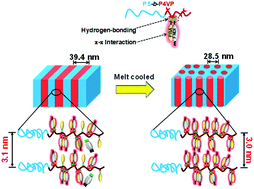Co-assembly of functionalized donor–acceptor molecules within block copolymer microdomains via the supramolecular assembly approach with an improved charge carrier mobility†
Abstract
Here, we demonstrate the three-component self-assembly of functionalized small molecules (donor and acceptor) and a polystyrene-block-poly(4-vinylpyridine) (PS-b-P4VP) block copolymer using the supramolecular approach. The introduction of functional groups on both the donor (1-pyrenebutyric acid, PBA) and acceptor (functionalized naphthalene diimide, FNDI) molecules can form stable charge-transfer (CT) complexes within the block copolymer domains and these supramolecules exhibited a charge carrier mobility of around 1.01 × 10−4 cm2 (V s)−1. In this case, both the molecules can form H-bonding with P4VP chains, and as well as π–π stacking between the PBA and FNDI molecules is also possible within the block copolymer domains. These noncovalent interactions lead to the formation of stable hierarchical structures and CT complexes between PBA and FNDI, where bilayer donor–acceptor (D–A) stacks formed within the block copolymer microdomains. Overall, the organization of both functionalized donor and acceptor molecules within the block copolymer domain exhibits an enhanced charge carrier mobility, which is potentially useful in the fabrication of organic photovoltaic cells and organic light-emitting diodes.



 Please wait while we load your content...
Please wait while we load your content...